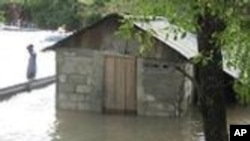The Plaine du Cul de Sac was once the breadbasket of Haiti. But decades of deforestation have resulted in serious soil erosion. Canals that once irrigated crops have been buried by mud slides and floods. Today the government and people of Haiti, with the help of the United States and international non-governmental organizations, are working to make the Plaine du Cul de Sac the fertile farmland it once was.
With $800,000 in financing provided by the United States Agency for International Development, or USAID, the amount of arable land in the plain has grown from 1,300 hectares to 4,000 hectares in less than a year, giving as many as 30,000 farmers the opportunity for a better life. Sixteen kilometers of primary canals and 46 kilometers of secondary canals are being refurbished in the Plaine du Cul de Sac by a USAID partnership with the International Organization for Migration and the Cooperative Housing Foundation.
Haiti's Ministry of Agriculture and Development and local authorities, including Saint-Ange Darius, the mayor of Croix des Bouquets, are supporting the project. Rock walls are being constructed further up the plain to protect the irrigation system's intake area from periodic flooding by the Gris River. A system of sluices directs the water flow in seven directions to the canals.
Approximately 70 percent of Haiti's 9 million people work the land. Reviving agricultural production is critical to generating jobs and feeding a hungry country that was among the first to experience urban rioting during the 2008 food crisis.
USAID's Acting Deputy Director in Haiti, Alex Deprez, said that since problems faced by farmers, such as poverty and hunger, also impact nearby cities, USAID's strategy for Haitian development is shifting. "We are moving from treating urban hotspots with projects that prioritize security and short-term job creation to creating zones of greater economic opportunity," he said. The United States is committed to working with Haiti to ensure a prosperous future for all Haitians.














